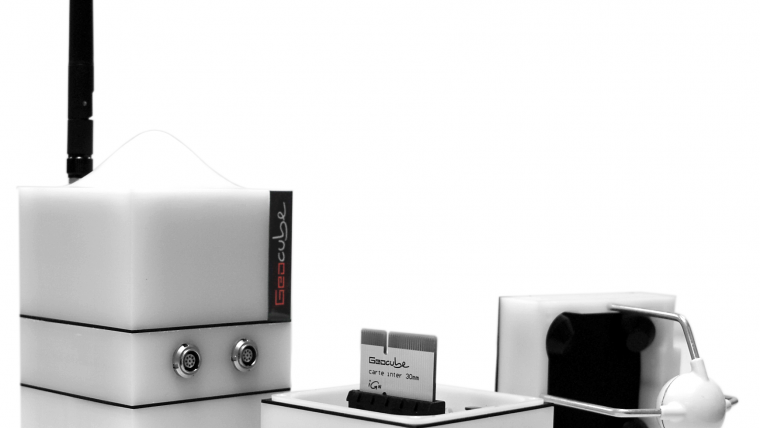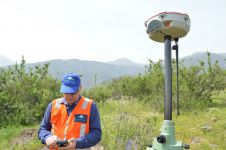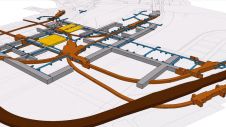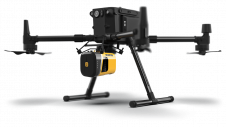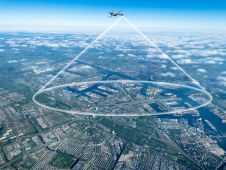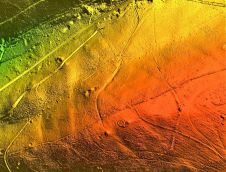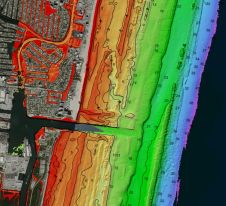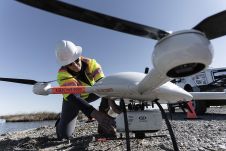Low-cost GPS Sensors for Deformation Monitoring
Monitoring Deformations on a Glacier with Wireless Sensor Networks
Deformation monitoring of glaciers is of great value to scientists with an interest in climate change. Due to the slow movements of glaciers, a semi-permanent deformation system is the best method to monitor the changes. Using low-cost GPS receivers that work in a wireless sensor network makes such a set-up feasible.
Glaciers are large bodies of ice moving slowly downhill under the forces of gravity. On the way down, the ice deforms, creates crevasses, speeds up and slows down. The process involves huge forces. Monitoring these movements is of great scientific interest, but due to the slow dynamics a semi-permanent solution is required. Nevertheless, a high spatial resolution is desirable: if one can measure movement at many different points, the full dynamics can be described in much more detail. Such monitoring solutions are now available thanks to low-cost GNSS modules operating in a so-called wireless sensor network (WSN).
Low-cost GPS
Over the last few years, the expansion of mobile systems has led to low-cost and low-energy components, including GPS modules providing L1-frequency raw carrier-phase data, similar to the capability of geodetic-grade receivers. These modules are now available for less than USD100. Such GPS modules are often used for georeferencing. They usually only provide a metre-level accuracy derived from the GPS code signal alone, but by employing geodetic concepts such as carrier phase measurement and relative positioning it is possible to achieve accurate positions in the WSN. Effectively, this transforms the WSN into a deformation monitoring system.
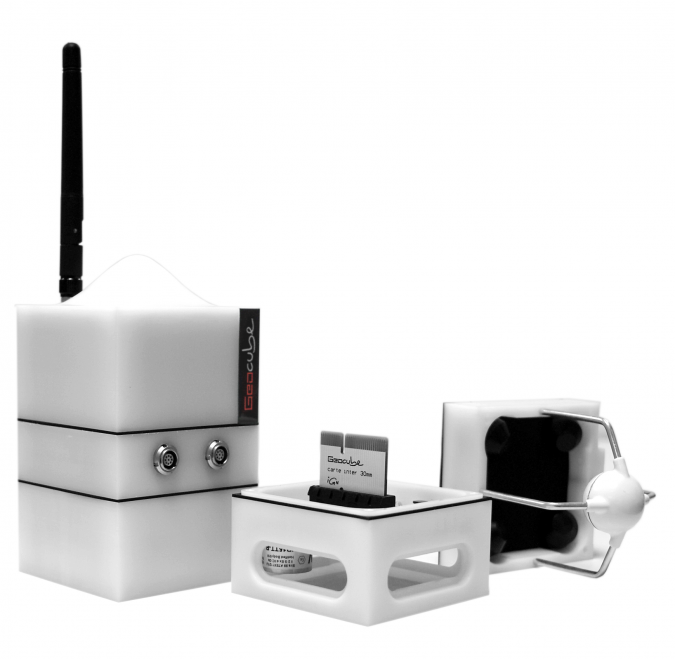
Geocubes
Within a WSN, multiple devices work in unison to measure environmental parameters continuously. The targeted size of a WSN for deformation monitoring is 10 to 50 devices distributed over an area of around 1km². The French National Institute of Geographic and Forest Information (IGN-France) has developed devices for such a WSN called Geocubes (Figure 1). The Geocubes include all the basic functionalities, namely a battery, a GPS chip for positioning and timing, a computer to manage data acquisition and storage, and a radio module for data exchange. Solar panels are used for the power supply, making it possible to abandon the receivers on the field as long as required by the survey. To achieve precise timing of all collected data in the network in one time scale, the computer clock is controlled by GPS to reach 100-microsecond accuracy. The Geocubes are designed to enable modular addition of several environmental sensors such as meteorological sensors, piezometers or seismographs. The device provides an interface to these modules through data exchange protocols and several connectors using serial connection or 64-pin board-to-board plugs. A Geocube measures 7cm on each side and costs around USD1,000. Hence, it is sufficiently affordable for dense networks to be set up comprising numerous devices.
Network operation
Central to every WSN is the network-based operation. All the complex tasks such as data centralisation, data processing, data storage in a database or network management are accomplished by a master node, called the coordinator (Figure 2). The Geocubes transmit data wirelessly to the coordinator. This makes the Geocubes unsophisticated and thereby robust, and also reduces the energy consumption of the Geocubes. The coordinator is set up on the field in the vicinity of the network (Figure 3),needing careful installation. Because it acts as the brain of the network, it is resource- and energy-consuming and hence requires a large solar panel as power supply. Moreover, since the coordinator is the central component of the network, service interruption must be avoided. Remote users connect to the coordinator over an internet link, which could be a wired, 3G or satellite connection, depending on the application. The user can subsequently query the database and visualise the data or change the sensing settings.
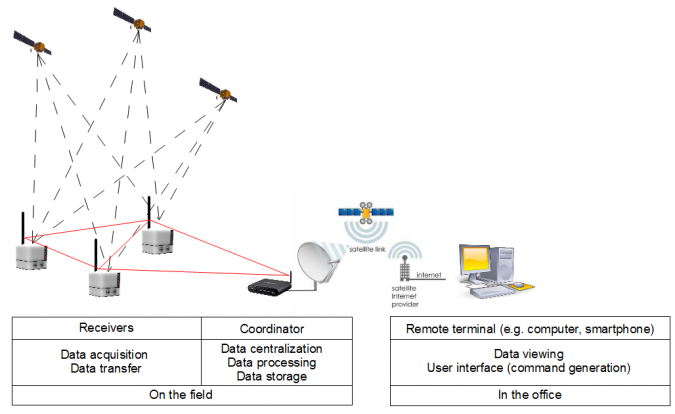
Positioning
GPS卫星提供两个定位信号,namely L1 and L2, each with a different frequency. High-end geodetic receivers perform carrier-phase measurements on both frequencies which allow them to correct for ionospheric delay, one of the larger error sources in GPS. They can do this because the effect of ionospheric delay is different for the L1 and L2 frequencies. The cheaper GPS receivers used in a WSN only observe the carrier phase on the L1 signal. However, it is not necessary to achieve accurate absolute positions; it is sufficient to know how much change there is in the baseline between two GPS stations, as this is effectively the deformation. As long as the baselines are shorter than 1km, this can be measured accurately with the L1 signal alone.
Once data has been centralised in the coordinator, an extended Kalman filter computes the positions of the nodes from double differences in real time. This consists of a linear combination of the observed carrier phase by two receivers and two satellites simultaneously. With double differencing, clock errors can be discarded while errors due to the ionosphere and troposphere are reduced. The Kalman filter improves the accuracy of the observations by assuming an expected movement for each point and integrating all observations in a time series. The positioning software runs in the coordinator. Network processing is carried out using the raw carrier-phase data collected by all the active nodes of the network. As a result the position of the moving devices is obtained in a reference frame fixed by at least 3 Geocubes set up in stable locations in the vicinity. The resulting position time series of each Geocube involved in the survey has a temporal resolution of up to 1 second and a precision of 1cm standard deviation (Figure 4).
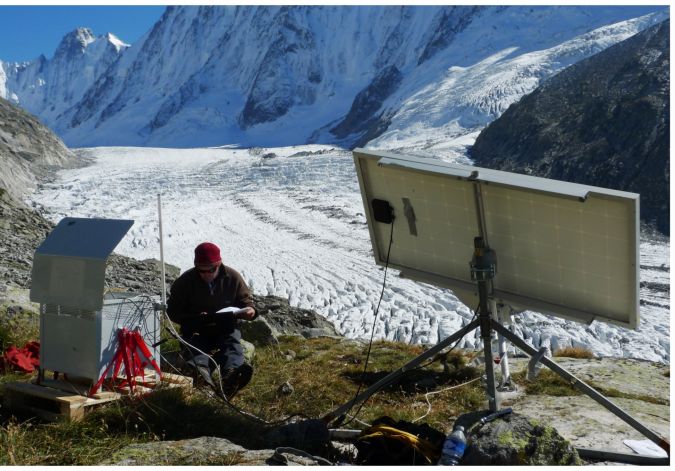
Additional data
The recorded displacements and deformations can be contextualised using extra measurements from additional sensors added to the WSN. This facilitates the analysis of position time series and deformations. In addition, it monitors data acquisition conditions and thus makes the data more reliable. For instance, the stability of the receivers can be checked using inclinometers, thereby ensuring the stability of the mounting of the sensing nodes.
Application
In order to test a Geocube network, 13 Geocubes were used to study the dynamics of the Argentière glacier in the Mont Blanc massif in France. The aim of this survey was to better understand the acceleration of the ice surface in response to heavy rainfall occurring during the autumn. From 13 September to 14 November 2013, 11 Geocubes were fixed on the ice in a 800m x 300m uncrevassed area of the glacier while two additional receivers were set up on the stable banks of the glacier to reference the survey. A coordinator was set up near one of the stable receivers to manage the network. Hence, the temporal and spatial variability of the ice surface velocity could be precisely monitored. The accuracy and the reliability of the Geocube survey was checked by comparing the results with external deformation measurements carried out using terrestrial photogrammetry and satellite synthetic aperture radar. The Geocubes successfully showed velocity heterogeneity in the studied glacier after heavy rainfall.
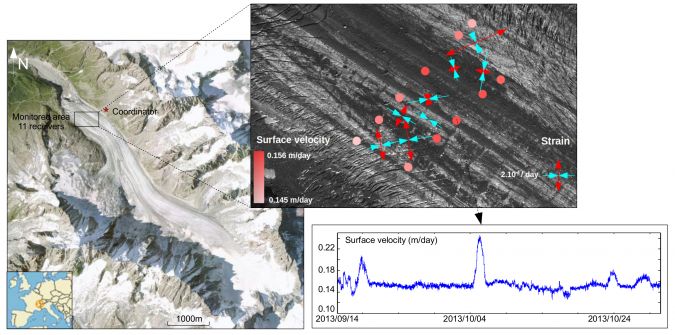
Further reading
Benoit L, Briole P, Martin O, Thom C, 2014, Real-time deformation monitoring by a wireless network of low-cost GPS,Journal of Applied Geodesy, Volume 8, Issue 2, 119-128.
Buchli B, Sutton F, Beutel J, 2012, GPS-equipped Wireless Sensor Network Node for High-accuracy Positioning Applications, in: Proceedings of the 9thEuropean Conference on Wireless Sensor Networks (EWSN 2012), pp. 179-195.
Takasu T, Yasuda A, 2009, Development of the low-cost RTK-GPS receiver with an open source program package RTKLIB, International Symposium on GPS/GNSS, International Convention Center Jeju, Korea, 4 -6 November 2009.
Make your inbox more interesting.Add some geo.
Keep abreast of news, developments and technological advancement in the geomatics industry.
Sign up for free
